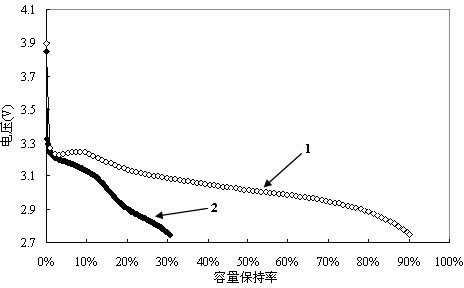Electrolyte of lithium ion battery
A lithium-ion battery and electrolyte technology, applied in secondary batteries, circuits, electrical components, etc., can solve problems such as difficult lithium battery applications, achieve good low-temperature performance, and improve the effect of high-temperature inflation
- Summary
- Abstract
- Description
- Claims
- Application Information
AI Technical Summary
Problems solved by technology
Method used
Image
Examples
Embodiment 1
[0012] An electrolyte solution for a lithium ion battery, including electrolyte, solvent and additive, wherein the solvent is a mixture of ethyl acetate EA, dimethyl carbonate DMC and ethylene carbonate EC. The weight percentage of ethyl acetate EA in the whole electrolyte solvent is 30-40%, the weight percentage of dimethyl carbonate DMC in the whole electrolyte solvent is 20-35%, and the weight percentage of ethylene carbonate EC is The weight percent content in the whole electrolyte solvent is 20-35%.
[0013] The additive is a mixture of propylene carbonate PC, lithium difluorooxalate borate LIODFB, polyoxyethyl ether and vinylene carbonate VC. The weight percentage of propylene carbonate PC in the whole electrolyte is 5%, and the weight percentage of difluorooxalate lithium borate LIODFB in the whole electrolyte is 3%,
[0014] The electrolyte is lithium hexafluorophosphate LiPF 6 . The concentration of the lithium hexafluorophosphate in the whole electrolyte is contro...
PUM
 Login to View More
Login to View More Abstract
Description
Claims
Application Information
 Login to View More
Login to View More - R&D Engineer
- R&D Manager
- IP Professional
- Industry Leading Data Capabilities
- Powerful AI technology
- Patent DNA Extraction
Browse by: Latest US Patents, China's latest patents, Technical Efficacy Thesaurus, Application Domain, Technology Topic, Popular Technical Reports.
© 2024 PatSnap. All rights reserved.Legal|Privacy policy|Modern Slavery Act Transparency Statement|Sitemap|About US| Contact US: help@patsnap.com









